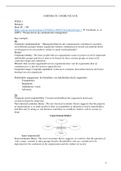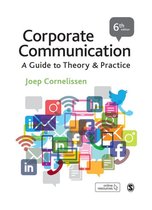CORPORATE COMMUNICATIE
WEEK 1
Bronnen:
Boek H1 + H4
https://canvas.uva.nl/courses/14190/files/1690233/download?wrap=1 Van Ruler, A. A.
(2005). “Perspectieven op communicatie management
Key concepts
H1
Corporate communication: “Managementfunctie die communicatie coördineert waardoor
verschillende groepen binnen organisatie kunnen communiceren terwijl een uniform beeld
wordt gegeven en een positieve relatie in stand wordt gehouden”
Market
Corporate identity: The basic profile that an organization wants to project to all its important
stakeholder groups and how it aims to be known by these various groups in terms of its
corporate image and reputation.
Mission: Kan worden opgemaakt uit een organisatie door wat de organisatie doet of
communiceert, is dus niet precies opgeschreven.
Corporate image/ Corporate reputation: Collectieve evaluatie (merendeel mensen deelt deze
mening) van een organisatie
Stakeholder engagement: het betrekken van stakeholders bij de organisatie
- Transparency
- Integration
- Authenticity vision
- Advocacy
H4
Corporate social responsibility: Verantwoordelijkheid die organisatie heeft naar
sociale/ecologische omgeving
Neo-classical economic theory: The neo-classical economic theory suggests that the purpose
of organizations is to make profits in their accountability to themselves and to shareholders,
and that only by doing so can business contribute to wealth for itself as well as society at
large
Input-outputmodel:
Socio-economic theory: The socio-economic theory suggests, in contrast, that the question of
‘who counts’ extends to other groups besides shareholders who are considered to be
important for the continuity of the organization and the welfare of society
1
, Stakeholder model:
Economic/market stake: Economic or market stakes are held by those who have an economic
interest, but not an ownership interest, in the organization, such as employees, customers,
suppliers and competitors.
Equity stakes: Equity stakes, in Freeman’s terminology, are held by those who have some
direct ‘ownership’ of the organization, such as shareholders, directors or minority interest
owners.
Influencer stake: Influencer stakes are held by those who do not have either an ownership or
economic interest in the actions of the organization, but who have interests as consumer
advocates, environmental groups, trade organizations and government agencies.
Stakeholder: elke groep/individu die invloed heeft op / beïnvloed wordt door gedrag
organisatie
Stakeholder engagement:
o Tweewegscommunicatie (symmetrisch)
o Groep actoren samen
o Focus op bouwen relaties met stakeholders
o Relationele benadering
Stakeholder management:
o Top-down (asymmetrisch)
o Organisatie centraal
o Managen stakeholders uit belang organisatie
o Informatieve + persuasieve benadering
Stakeholder salience legitimacy
Power-interest matrix
2
,Dialogue strategy: both parties (organizations and stakeholders) mutually engage in an
exchange of ideas and opinions. a dialogue strategy involves the active consultation of
stakeholders and, at times, even the incorporation of important stakeholders into the
organization’s decision-making. It involves working towards a process of mutual
understanding and mutual decisions rather than strategic self-interest on the part of the
organization.
Persuasive strategy: an organization, through campaigns, meetings and discussions with
stakeholders, tries to change and tune the knowledge, attitude and behaviour of stakeholders
in a way that is favourable to the organization. Corporate advertising and educational
campaigns, for example, are often used to create a favourable image for the organization and
to ‘sell’ a particular kind of understanding of the organization’s decisions, its corporate
values and its products and services
Informational strategy: a strategy of informing someone about something. Press releases,
newsletters and reports on a company website are often simply meant to make information
available about the organization to its stakeholders. Such a strategy may create awareness of
organizational decisions and may also contribute to a degree of understanding of the reasons
for these decisions.
Benaderingen van Ruler:
3
,WEEK 2
Brand(ed) identity
Corporate brand
Corporate identity
Corporate personality
Corporate reputation
Culture Vision
Design Alignment
Brand portfolio
Social identity
Symbolism
Organizational identity
Corporate image
Bronnen:
Boek H5
Hatch, M. J., & Schultz, M. (2002). The Dynamics of Organizational Identity. Human
Relations, 55(8), 989-1018
WEEK 3
Important concepts are:
- Issue lifecycle
- Issue arena's
- Issue management
- DESTEP & SWOT
- Stakeholder positions (position-importance matrix)
- Buffering, Bridging, Advocacy & Thought Leadership
- Resilience
- Corporate Social Responsibility
- Greenwashing
- CSR Communication
- Community relations
4
,Bronnen:
Boek H10 + H13
Vos, M. (2017) Communication in Turbulent Times: Exploring Issues and Crisis
Communication to Enhance Organisational Resilience. Reports from the School of Business
and Economics, University of Jyväskylä
= issue arena etc
WEEK 4
Agenda-setting
Agenda-building
Framing
Paid media/earned media/owned media
Crisiscommunicatie + strategieën
Boek H8 + H11
Van Gorp, B., & van der Goot, M. J. (2012)
= stakeholder frames
WEEK 5
Key concepts:
Public Affairs (e.g. Lobbying, Grass roots, Astroturf)
Public Affairs skills and tools
Media relations
Investor relations (e.g. communication tools)
Shareholders
Financial reputation
Bronnen:
Thomson, S., & John, S. (2006). Public affairs in practice: a practical guide to lobbying.
Kogan Page Publishers.
Chapter 1: Introduction
= public affairs + lobbying
Gackowski, T. (2017). The idea of investor relations in the modern economy: a
communication approach. Economic research-Ekonomska istraživanja, 30(1), 1-
13. (Koppelingen naar een externe site.)
= investor relations
Obermann, W.D. (2017) Lobbying Resources and strategies In: Harris, P., & Fleisher, C. S.
(Eds.). The SAGE Handbook of International Corporate and Public Affairs. Sage.
= Acces + legitimacy etc
WEEK 6
Key concepts:
Organizational identification
Organizational voice and silence
Organizational culture
Corporate information and communication systems (CICS)
New Ways of Working (NWW)
5
, Excellent organisations
Bronnen:
Boek H9
Miller, K. & Barbour, J. (2014). Organizational Communication: Approaches and Processes.
Stamford: Cengage Learning.
Chapter 4: Systems and Cultural Approaches [only the section on cultural approaches]
= Descriptive + prescriptive approach cultuur
Demerouti, E., Derks, D., Lieke, L., & Bakker, A. B. (2014). New Ways of Working: Impact
on Working Conditions, Work–Family Balance, and Well-Being. In The Impact of ICT on
Quality of Working Life (pp. 123-141). Berlin: Springer.
= New Ways of Working
WEEK 7
Key topics:
Organizational change
Identified problems in organizational change
Change communication strategies
Storytelling
Framing
Sensemaking & sensegiving
Bronnen:
Miller, K. & Barbour, J. (2014). Organizational Communication: Approaches and Processes.
Stamford: Cengage Learning.
Chapter 10: Organizational Change and Leadership Processes [only the section on
organizational change]
=
Lewis, L. (2011). Organizational change: Creating change through strategic communication
(Vol. 4). John Wiley & Sons.
Chapter 2: Processes of Communication during change
Chapter 8: Stakeholder Interactions: Storytelling and Framing
6





